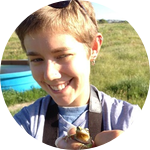About This Project
"My goal is to help protect California's natural legacy in an increasingly modified landscape, with the potential to shed light on countless other inter-species competition paradigms."
Ask the Scientists
Join The DiscussionWhat is the context of this research?
My goal is to help preserve California’s biodiversity by discovering methods to promote coexistence between native red-legged frogs and invasive bullfrogs. The California Red-Legged Frog (CRLF; Rana draytonii) is California’s largest, and perhaps most famous, native frog species. Mark Twain, in an 1865 short story that represented his first great success as a writer, legendarily called it the Celebrated Jumping Frog of Calaveras County. In Twain’s time, CRLF occurred in great abundance throughout California. Yet today, this famed frog is considered to be a threatened species, and has been extirpated from much of its range. The status of the West Coast's most famous amphibian has been most dramatically affected by the invasive American Bullfrog (Rana catesbeiana). This invasive large-bodied frog predates on and out-competes many native amphibian species, both California and worldwide. It has had particularly strong effects on the Red-Legged Frog due to both species' similar ecological niche. In many areas, CRLF have been, or are currently being, radically displaced by bullfrog invaders. Yet remarkably in other regions, apparent coexistence of the two species has been observed. My field studies seek to explain this phenomenon of coexistence. To this end, I survey ponds under three conditions: un-invaded ponds with CRLF alone, ponds where CRLF and bullfrog coexist, and ponds where bullfrogs have excluded CRLF. At each of these sites, I quantify abundance and microhabitat use of both species, to determine if CRLF modify their population size or behavior in the presence of a large predator. I am also quantifying habitat characteristics such as canopy cover or upland slope to determine if these factors can promote survival of CRLF.
What is the significance of this project?
My research will contribute new ideas for the conservation and management of California's native amphibians. Current management paradigms are defined by constant, costly, and generally ineffective bullfrog removal efforts. In today's dire economic circumstances, these eradication programs misutilize increasingly dwindling public funds. If I can determine that CRLF are capable of coexisting with bullfrogs under certain habitat conditions, management could become more effective for conservation of native species. My goal is to help protect California's natural legacy in an increasingly modified landscape, with the potential to shed light on countless other inter-species competition paradigms. My work will advance ecological theory by demonstrating the unique conditions in which native species can be expected to survive while in the presence of an invasive intraguild predator, such as the cane toad in Australia. And perhaps most significantly, it will help to save one of the West Coast's most well-known frogs, and once again elevate Mr. Twain's celebration of the California Red-Legged Frog to near-mythical heights.
What are the goals of the project?
I'm proud to say that field herpetology is accomplished with relatively few supplies (mostly dip nets, hip waders, and a clipboard!), but these small expenses can pile up over the course of a months-long field season. My main costs are gas (many of my field sites are several hours apart), small field supplies such as headlamps and batteries, and decontaminating equipment to avoid spreading amphibian disease. It doesn't take too much to make a lot of progress toward increased knowledge and conservation of this delightful amphibian. Donate $50 or more, and I'll name a frog after you! You'll receive a high-quality color photo of the frog, and updates every time the frog is recaptured.
Budget
This budget will fully fund my travel and equipment expenses for the 2014 field season. I will be conducting surveys for California Red-Legged Frogs from February to September. I travel by car to each of my field sites at least once every 3 weeks to observe the life stages present in each population. The sites (ponds at San Jose, Santa Cruz, Monterey, Carmel, and Pinnacles Nat'l Park) average a 3 hour distance from Davis, my home institution. Field equipment that I’ll need this season includes waders for me and for my assistants, dip nets, field guides, a handheld GPS for marking locations, scales and rulers for measuring adult frogs, and plenty of headlamps and batteries for our night surveys. Decontamination supplies include tupperware bins for dunking equipment, gallons of 3M Quat disinfectant cleaner, and individual ziploc bags for obtaining frog body weight.
Meet the Team
Affiliates
Team Bio
I'm currently a 3rd year graduate student at UC Davis, studying issues in amphibian conservation and invasion ecology. I've worked in aquatic systems from pond turtle population dynamics to the food chains of dragonfly larvae, and loved every minute of it. If you want to know more about the project, California Red-Legged frogs or amphibians in general, freshwater aquatic ecology, or conservation biology, email me at rbanderson@ucdavis.edu!Rachel Anderson
I'm currently a 3rd year graduate student at UC Davis, studying issues in amphibian conservation and invasion ecology. I've worked in aquatic systems from pond turtle population dynamics to the food chains of dragonfly larvae, and loved every minute of it. If you want to know more about the project, California Red-Legged frogs or amphibians in general, freshwater aquatic ecology, or conservation biology, email me at rbanderson@ucdavis.edu!
Project Backers
- 28Backers
- 100%Funded
- $2,500Total Donations
- $89.29Average Donation
